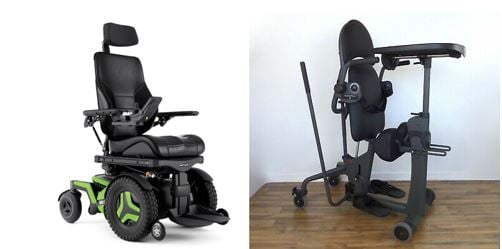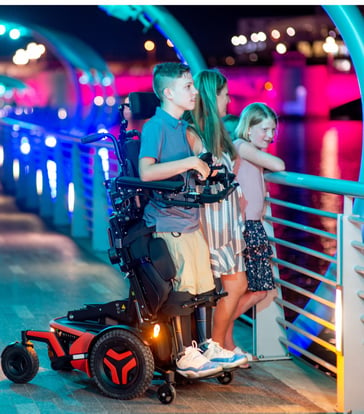Power wheelchairs that offer the option of power standing have several physiological and functional benefits, however accessing funding for these chairs can be challenging. Funders are keen to fund the most cost-effective option, in many instances this is provision of a separate power wheelchair and standing frame.

Having two separate solutions may work well for some, particularly for those who are unable to manage the complexities of a power stand up chair or those who have a well-established routine in place with a standing frame. However, for others having a two separate solutions may not be ideal, in this blog I am going to focus on two common examples.
For many teenagers or young adults, regular use of a standing frame can become challenging due to a variety of reasons – it may no longer fit well into the school routine, transfers in/out of the standing frame may be challenging, or the limited mobility while in the standing frame, and often time away from their peers, creates issues with compliance. This can result in limited opportunities for standing and weight bearing at a time when they are moving through puberty and a rapid period of growth.
For some of these young adults, there is potential to demonstrate how provision of a power stand up chair can be cost effective, often through demonstrating the potential to reduce carer support hours and with functional gains leading to increased independence. If a young adult has, or may soon need, carer support hours to assist with transferring in/out of their standing frame, these are hours that are no longer needed with a power stand up chair. A young adult also has the potential to increase their independence with access to power standing, particularly if they have reasonable hand function. Provision of a power stand up chair may mean that a teenager or young adult can come home from school independently, being able to access their home and food from the pantry or fridge and have independence at home without needing their parents or a carer. Some teenagers or young adults, particularly males, may also be able to use the toilet independently with use of power standing, further increasing their ability to be at home or school without support. A power wheelchair with power standing often results in increased function, or reduced need for support, at school, typically in science and technology subjects. Science and technology are subjects that are typically undertaken at raised tables or in an environment where a person is standing, making access to these subjects from a wheelchair more challenging. Use of power standing can reduce the need for environmental modifications and a person may be able to participate in these subjects alongside their peers.

Another group of wheelchair users where access to power standing can often be easily justified are those with conditions that create increased tone in their lower limbs, limiting their ability to stand and walk. For this group, regular standing or weight bearing often assists with managing their increased tone, prolonging their ability to stand transfer. For many their ability to stand independently declines over time, and a standing frame may be considered, however independent transfers in/out of the standing frame may also be an issue. For these people access to power standing can result in a reduction in the number of carer support hours required – in the short term as assistance is not required to manage a standing frame, and potentially in the medium term as independent transfers are maintained for longer. Further cost benefits may occur if use of power standing maintains a person’s independence with activities of daily living at home and/or reduces the need for modifications to their environment.

When completing funding requests for a power wheelchair with power standing, a person’s goals is often the best place to start – particularly those that are likely to maintain or increase their independence. These goals can be complemented with information on their carer support package – and how this may change if the goals are achieved. For those who were previously had some mobility on their feet, provision of power standing may allow a person to remain living at home independently or with minimal support, while for some teenagers and young adults, there can be a significant reduction in carer support hours, or reduced reliance on family, with provision of power standing due to an increase in functional abilities and the resulting independence it gives them. This ability to maintain a current support package, or potentially reduce the number of carer support hours required, can be an objective way of demonstrating to the funders that a power wheelchair with power standing is a cost-effective option.
For more information on power standing on our Permobil chairs, please contact Sales.NZ@permobil.com
Rachel Maher
Clinical Education Specialist
Rachel Maher graduated from the University of Otago in 2003 with a Bachelor of Physiotherapy, and later gained her Post Graduate Diploma in Physiotherapy (Neurorehabilitation) in 2010.
Rachel gained experience in inpatient rehabilitation and community Physiotherapy, before moving into a Child Development Service, working with children aged 0 to 16 years.
Rachel later moved into a Wheelchair and Seating Outreach Advisor role at Enable New Zealand in 2014, complementing her clinical knowledge with experience in NZ Ministry of Health funding processes.
